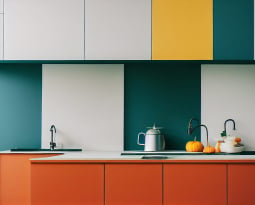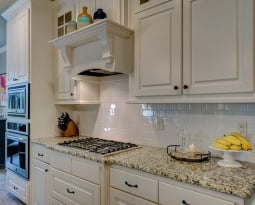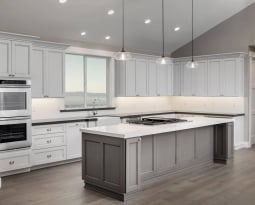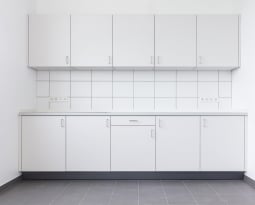Kitchen Cabinet Dimensions: Your Guide to the Standard Sizes
Are you looking to update your kitchen cabinets? There’s more to it than choosing the colors and styles you like.
Knowing what sizing options are available and what fits best in your kitchen is an essential aspect of remodeling.
Here’s a simple, complete guide to your basic kitchen cabinet dimensions so you can figure out what size is best for you.
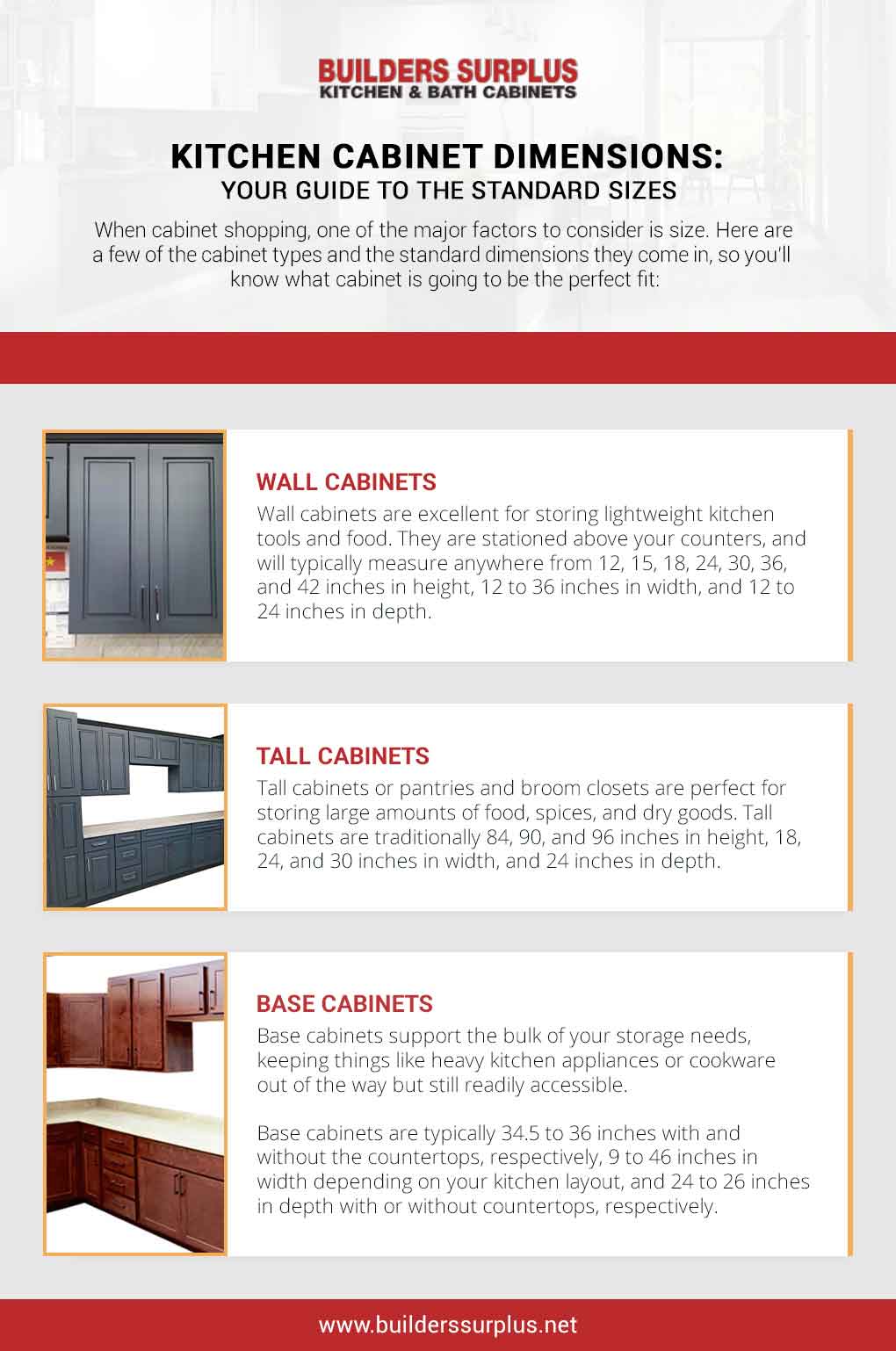
Kitchen Cabinet Dimensions: 101
Sure, it’s fun to tinker around with different ideas for cabinet colors, styles, or materials. However, when it comes down to it, if you don’t get the cabinet dimensions right, they’re going to look funky and likely be non-functional.
This guide provides a list of standard cabinet dimensions. Unless you have ultra-customized cabinetry in mind, this will list the basic dimensions you’re most often going to be choosing from.
Wall Cabinets Dimensions
These are the cabinets attached above counters and not touching the ground. They are generally used for storing lightweight kitchenware or food and attach directly to your kitchen walls via studs.
Wall cabinets set the tone for your kitchen as they are eye level and used most often. These tend to be the more fun cabinets as you can add lighting, glass, and other features to add more personality to your kitchen.
Now down to the dimensions:
| Height | Width | Depth |
|---|---|---|
| 12, 15, 18, 24, 30, 36, and 42 INCHES | 12-26 INCHES | 12-24 INCHES |
- Height- 12, 15, 18, 24, 30, 36, and 42 inches.
-
- Wall cabinet heights are typically limited as they must fit between kitchen countertops and ceilings. You will find the heights for these listed as, 12″, 15″, 18″, 24″, 30″, 36″, and 42″.
-
- 12-inch cabinets are those you place above a fridge.
- Width- 12-36 inches.
- Standard width for a single or double door wall cabinet is generally available in widths from 9″ to 36″, we carry them in increments of 3″ (i.e., 9″, 12″, 15″).
- Depth- 12-24 inches.
- Standard wall cabinets are generally 24 inches in depth.
Tall Cabinets Dimensions
These are what you find for pantries or broom closets. They are less common but very helpful when they are installed correctly. You can choose these in a size long enough to extend from your floor to the ceiling.
Here are tall cabinet basic dimensions:
| Height | Width | Depth |
|---|---|---|
| 84, 90, AND 96 INCHES | 18, 24 AND 30 INCHES | 24 INCHES |
- Height- 84, 90, and 96 inches.
-
- When it comes to height for these cabinets, you have three options.
-
- You can select cabinets to reach from floor to ceiling, or you can have the 84-inch cabinet that leaves about a foot up top between the cabinet and ceiling. This is usually where you add some cuties ceramic rooster or potted plant.
- Width- 18, 24, and 30 inches.
-
- Here, we include 18, 24, and 30 inches.
-
- 24 inches is a moderate size that looks good in most kitchens.
-
- 30 inches are for those looking to add pull-out drawers or perhaps use the space for more food storage.
- Depth- 24 inches.
-
- Only 24 inches for depth.
- Deep cabinets are great for keeping food or utilities from getting lost in the dark abyss of your cabinets. They keep items up from and provide easier access.
-
- 24-inch cabinets are good for adding pullouts or drawers. You can store sliders or larger boxes in these deep cabinets.
Base Cabinet Dimensions
Don’t forget the base cabinets! These sturdy, essential pieces go right on the floor and do the “heavy lifting” when it comes to storage.
Base cabinets are usually where you store larger kitchen items like that KitchenAid mixer, large pots, and pans, and items you’re less likely to pull out every day.
Base cabinets have sinks installed within them. Countertops cover them and they surround stoves and dishwashers. Basically, they are the most expensive counters to install because they are the most versatile and must be the most sturdy.
Simply put, you could design a kitchen without wall or tall cabinets, but you can’t do without the base cabinet. But, enough about how vital they are. Let’s get down to dimensions:
| Height | Width | Depth |
|---|---|---|
| MINUS COUNTERTOPS-34.5 INCHES | 9-46 INCHES(IN 3 INCH INCREMENTS) | MINUS COUNTERTOPS-24 INCHES |
| INCLUDING COUNTERTOPS-35-36 INCHES | 9-46 INCHES(IN 3 INCH INCREMENTS) | INCLUDING COUNTERTOPS-25-26 INCHES |
- Height, Minus Countertops- 34.5 inches.
- Base cabinets can’t vary much in height. General design practices and building codes prevent variance in this. Base cabinets must be up to code and that means they must be “accessible.”
- Height, Including Countertops- 35-36 inches.
- This means that after you add the countertops, a base cabinet can be anywhere between 35 to 36 inches tall.
- Many designers and installers will quote the old adage, “countertops should fit the user.” This sometimes results in countertops at 32 inches or as high as 38 inches.
- Width- 9-46 inches (in 3 inch increments).
- The width of the base cabinets is the most variable dimension. The intended use of the base cabinet influences this decision.
-
- Here are a few examples of common uses and their equivalent width:
-
- 9, 12, 18 or 24 inches- Good for storing baking pans, spices, pull-outs, or narrow rolling-wracks.
-
- 30 inches- Used for single basin sinks.
- 33 inches- Used for offset sinks, or double basin sinks.
- 36 inches- Used for double basin sinks.
-
- 42 inches- This is the largest width in a base cabinet. Think lazy Susan size or simply something extra large.
- Here are a few examples of common uses and their equivalent width:
- Depth, Minus Countertops- 24 inches.
- The depth for base cabinets is the distance from the outer edge of the cabinet to the wall. This means less space inside than the actual number of inches you choose.
- If you had a deeper cabinet than 24 inches, it would be difficult to reach the back or plug-in appliances.
- Depth, Including Countertops- 25-26 inches.
- Often, countertops hang over the top front of base cabinets to obscure the edges. Depending on the countertop design, this overhang might add an extra inch or two.
Choosing the Kitchen Cabinets for You
Now that you’re armed with the basic rundown of standard kitchen cabinet dimensions, on to the more fun aspect of choosing styles and colors!
For ideas on what current styles are “in,” check out our blog post on 6 popular styles of kitchen cabinets.


